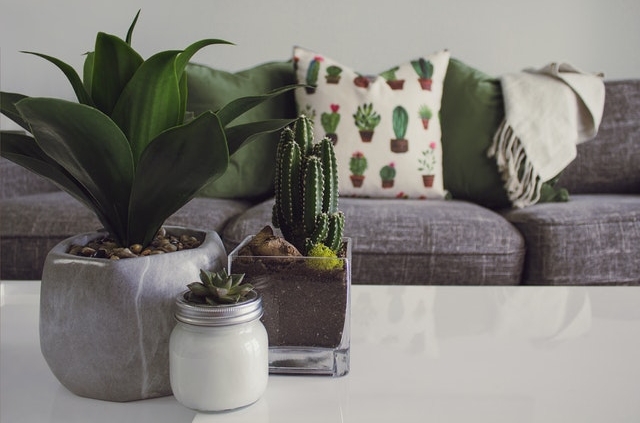7 Plants that Improve Your Home’s Air Quality
Clouds of dark gray smoke emitting from tall buildings, surrounded by a never-ending stream of cars and trucks. That’s the sort of image the average person will most likely conjure up when being asked to describe air pollution. While this image of air pollution is both truthful and threatening, many people don’t realize that it doesn’t accurately depict the worst air quality you are likely to experience on a daily basis.
So, where is the worst air quality? Maybe in your own living room. That’s right. Your own sweet humble abode could be contaminated with stagnant and poorly ventilated air. Trapped with nowhere to go, this air wreaks havoc on your home and your health with its invisible cloud of toxicity.
In fact, according to the EPA, indoor air pollution levels are generally 2 to 5 times greater than outdoor pollutions levels. Unsuspecting culprits such as furniture, candles, air fresheners, chemical-laden household cleaners, and even printers are all combining to make your home a pollution playground.
Depressing news: is there any way to remedy it?
Yes! It’s Mother Nature to the rescue.
As it turns out, there are several different types of plants that can act as natural air filters for your home!
How so?
When plants absorb carbon dioxide, they also do us a major solid by taking in some of the other nasty particulates from the air at the same time. Tiny microbes present in certain plant’s soil also work to clean the air, according to NASA.
Not to mention plants also make for some nice home decor.
Let’s take a look at the top seven plants that make for the best natural air filters.
1. Boston Fern
The Boston fern reigns supreme when it comes to tackling formaldehyde, a byproduct of chemical based cleaners and paints, among other things.
And it also does a pretty killer job at tackling benzene and xylene, pollutants that exist in car exhaust that like to creep indoors from attached garages.
These plants are a little high maintenance, but caring for them is definitely doable.
They love moisture and prefer to be watered on the regular. This can be daily, depending on the moisture and humidity levels in your home.
Boston ferns thrive in high humidity, indirect light, and a good soak down once per month.
2. Spider Plant
If you’re just starting to test out your green thumb, spider plants are a great place to start. Honestly, you kind of have to try to kill these plants.
Spider plants do a great job of combating some of the most common household air pollutants like benzene, formaldehyde, carbon monoxide and xylene, a solvent used in the printing, rubber and leather industries.
These plants are also pet-friendly and are just about as easy to regrow as they are to keep alive. All you need to do is cut off one of the “spiders” and place it in a new pot.
Spider plants love cool to warm temperatures, indirect sunlight, and dry soil.
3. Aloe Vera
Aloe vera is one of those plants that has so many superpowers it practically deserves its own post.
This easy-to-grow succulent helps your home say goodbye to both formaldehyde and benzene.
It can do a lot more than just clean the air, however.
Aloe vera can also help heal cuts and burns, soothe skin irritations, alleviate constipation, moisturize the hair and scalp, aid in digestion, and boost the immunue system. All you have to do is crack open one of the leaves and make use of the gel inside.
In fact, people have been making use of the aloe vera’s magical powers for thousands of years. Egyptians even referred to it as the “plant of immortality.”
This hardworking plant loves the sun and makes the perfect piece of decor on a coffee table top or a kitchen window.
4. Peace Lily
Don’t be confused by its name. This plant is anything but peaceful when it comes to doing away with harmful air pollutants.
The peace lily is capable of removing three of the most volatile organic compounds (VOCs)- formaldehyde, benzene, and trichloroethylene, and it also does a pretty good job of fighting off toluene and xylene, compounds found in many household industrial products.
Another relatively low maintenance plant, the peace lily only requires some shade and weekly watering to thrive. What’s more, this plant gives you a friendly reminder when it needs watering by drooping its petals.
Be aware, however, the leaves can be poisonous to pets and children.
5. Chrysanthemum
Looking to give your home a splash of color?
Enter the chrysanthemum. A pretty plant that’s not afraid to go to town on some formaldehyde.
Choosy about the color scheme of your home?
You’re in luck with the chrysanthemum. This plant comes in nearly every color of the rainbow other than blue. Just double check when you’re buying that you’re getting the indoor variety and not the garden variety, as the garden one isn’t easy to maintain indoors.
These bright flowers are huge fans of bright sunlight and low humidity. Just make sure to water them under the leaves to prevent fungal infections.
6. English Ivy
Many gardening pros will warn to stay clear of the English Ivy for outdoor use, as it has a frightening ability to tear off gutters and damage your home’s exterior.
But bring it inside and it chills out. This plant can filter out formaldehyde and also reduce airborne fecal matter particles.
It’s ability to climb as it grows also makes it an excellent decorative piece.
The English Ivy loves moist soil and about four hours of sunlight per day.
7. Weeping Figs/Ficus
Native to Southeast Asia, the ficus also thrives indoors and can even grow up to 10 feet tall!
This plant helps fight pollutants that are typically found on carpeting and furniture.
The ficus prefers bright, indirect light, and can easily be transported outside when the weather conditions are warm enough.
Natural Air Filters, The Bottom Line
While these natural air filters can certainly make a dent in your indoor air pollution problem, it is always a good idea to invest in some man-made quality air filters as well.
Have you used any of the plants on the list as air filters for your home? Tell us about it in the comments below!
{source: articlecity}



